Yoga is a rich treasure with techniques beneficial for physical, mental, and spiritual well-being. In this era of expensive pharmacotherapy with innumerable side effects, it is difficult to manage diseases like hyperthyroidism or hypothyroidism, cardiovascular conditions, obesity, and diabetes.
Therefore, introducing physical exercises like yoga can gradually hasten the recovery process. Though it evolved and flourished in India, the introduction of yoga in Western culture gained much popularity and has become a statement of an optimum lifestyle in the upper-middle classes1.
Yoga involves a lifestyle that requires maintaining certain postures (Asanas) along with controlling breathing, thoughts, and enchanting mantras (recital phrases), unlike other exercises that focus on muscle stress, repetitive movements, and heavy breathing. In yoga, body is relaxed and blood requirement is reduced. This is opposite to aerobics, zumba and other exercises that increase the workload on heart to pump more blood. Yoga triggers the neuronal hormones that add significant benefits to mental and spiritual well-being1.
One of the countless postures in yoga is the ‘Shoulder stand’, also known as Sarvangasana.
Did You Know?
Sarvangasana is a posture where the whole body is balanced on the shoulder and is therefore, also known as a Shoulder stand.
Sarvangasana constitute 3 words “Sarva”, “anga” and “asana”. “Sarva” means “all”, “anga” means body part and “asana” means posture. As the name indicates, Sarvangasana is the posture involving the whole body.
It is referred to as the Queen of asanas because it maintains the physical and mental health of an individual2.
Asanas that involve postural inversion are not part of traditional practice, as the three classic hatha yoga texts do not mention these postures. They have only recently gained more popularity with increased visibility through social networks3. It is the most effective way to streamline the body and mind. It may help in attaining peace, containment and happiness4.
Sarvangasana or shoulder pose is to be practiced in the presence of trained yoga professionals. The steps to be followed while performing this asana are:
Do not strain your body by holding the final position for long during the initial practice. Increase the duration gradually from three to five minutes. Perform Sarvangasana only once during the yoga session2.
By regularly practising Sarvangasana, you can improve your posture, relieve back discomfort, and enhance overall spinal health. I recommend practising Sarvangasana (Shoulder Stand Pose) to alleviate stiffness in the back muscles caused by poor posture or prolonged standing. This pose involves stretching and lengthening the back muscles, helping to release tension and improve flexibility7.
Dr. Rajeev Singh, BAMS
Sarvangasana offers several benefits to improve physical and spiritual health. Some of the potential benefits are:
Sarvangasana may improve the blood supply to the brain. There is an increased influx of blood to the brain during the shoulder stand position. This increased influx can also help in nourishing the hair and hydrating the scalp, thus helping in preventing hair loss and improving hair growth.
An increase in blood supply to facial muscles may lead to glowing skin. The greater blood flow may also help in keeping ourselves active and energized2.
Sarvangasana may help in decreasing the production of thyroxin hormone responsible for causing hyperthyroidism. The inverted position during shoulder stand allows the heart to pump the blood to the brain and the thyroid gland and helps in curing thyroid-related disorders. The potential benefit of the blood flow during Sarvangasana is on respiration, increasing the digestive and excretory processes, and strengthening the nervous system, which is controlled by the thyroid and parathyroid glands. When the thyroid gland functions properly, all of the above-mentioned systems of the body work effectively2.
Kumar et al. 2017 mention a study5 involving 20 patients with diabetes (increased glucose level) subjected to 40 days of yoga, involving sarvangasana as one of the postures, showed a decrease in glucose levels and changes in insulin levels. The shoulder stand pose improves the functioning of pancreas, responsible for insulin production. The enhanced insulin production may help in decreasing the risk of diabetes. The involvement of asanas or postures in daily life does not have any adverse effects, and can be used as an alternate means to improve health4.
The shoulder stand may help in increasing the blood pressure of patients with low blood pressure. A study6 conducted by Naidu, S.T. et.al., 2015 on postural inversion in yoga and its effects on cardiovascular parameters, mentions that there was an increase in diastolic and systolic blood pressure during the sarvangasana. The increase in blood pressure depends on various factors especially the population (healthy or on patients with blood pressure fluctuations) performing the sarvangasana3.
Over the years, I have found that practising Sarvangasana (Shoulder Stand Pose) can help counteract the pooling of blood in the legs and abdomen. This pose involves elevating the legs above the heart, which promotes return of the blood from the organs and improves overall circulation7.
Dr. Siddharth Gupta, B.A.M.S, M.D (Ayu)
Also Read: Benefits of Halasana (Plough Pose) and How to Do It By Dr. Himani Bisht
Some of the contraindications related to Sarvangasana are:
The important point to consider while doing postural inversion is to perform it smoothly and slowly and it should be only practiced with a trained yoga teacher.
Also Read: Benefits of Prana Mudra and How to Do it By Dr. Himani Bisht
Tension and stress are part of everyday life, but they should not affect the mind and body. Performing sarvangasana helps de-stress by relieving the pain and increasing the blood supply to all parts of the body. However, it is necessary to follow precautions while performing sarvangasana to avoid the associated physical risks. Given the rising popularity of postural inversions in yoga, through social media, it is important to do additional research on the benefits and risks.
Also Read: Benefits of Bhramari Pranayama and How to Do it By Dr. Himani Bisht
Sarvangasana is also known as “shoulder stand”. It is an inversion posture where the whole body is balanced on the shoulder2.
People suffering from high blood pressure, slipped disc, vertigo, atherosclerosis, cerebral thrombosis migraine, pregnant and lactating women and people with diabetic retinopathy and who have undergone surgery should avoid shoulder stand. Sarvangasana should also be avoided in patients suffering from cold, flu and sinus problems2.
For beginners, the final position of Sarvangasana or shoulder stand should be held for a few seconds. It can be gradually increased with the practice for about three to five minutes2.
The shoulder stand or Sarvangasana may help in improving blood circulation and digestion. It may also help in rejuvenating the body and maintaining balance and posture of the body. Sarvangasana may increase blood pressure, which can be used as a potential benefit for patients with low blood pressure4.
This asana should only be performed once at the end of completion of other asanas during the yoga session. An easy relaxing posture after performing sarvangasana or shoulder stand is Shavasana (corpse pose)2.
Disclaimer: The information provided here is for educational/awareness purposes only and is not intended to be a substitute for medical treatment by a healthcare professional and should not be relied upon to diagnose or treat any medical condition. The reader should consult a registered medical practitioner to determine the appropriateness of the information and before consuming any medication. PharmEasy does not provide any guarantee or warranty (express or implied) regarding the accuracy, adequacy, completeness, legality, reliability or usefulness of the information; and disclaims any liability arising thereof.
Yoga, as mentioned in various Vedas and Upanishads, focuses on meditation, avoiding worldly attachments, and attaining harmony between our body, mind, and soul. This definition of yoga is completely different in the modern world, especially in Western countries that focus on techniques that are posture-based targeting physical fitness and relaxation1.
It is quite interesting to see how ancient amalgamates with modern bringing a beautiful product that is much in demand these days!1 Yoga helps in the integration of the internal environment with the external environment so a harmony is achieved in all possible aspects2. Asanas or postures have gained recognition and admiration as one of the potential approaches to gaining holistic health.
Did You Know?
Padmasana [pɑd-mɑ-sɑ-nɑ] is also known as Lotus pose4.
It is an ancient Indian practice, where a person sits in a cross-legged posture placing his/her feet on the opposite thighs. Lotus pose is an established meditative asana in Hindu, Jain and Buddhist traditions. Padmasana allows the body to be held completely steady for a longer period5.
Those who feel that the full lotus pose is intense can practice the easier version of Padmasana. In this variation, only one foot is put at the top of the opposite keeping the other foot under the out-stretched thigh. This version is known as the Ardh-Padmasana or Half-Lotus pose4.
Padmasana helps students in focusing and diminish stress, especially during exams. It holds the wandering thoughts and stabilizes the mind. The steadiness and calmness are the real steps toward meditation2. The lotus pose also encourages the digestive process and tones sacral nerves (nerves that provide control to the pelvis and legs) by increasing the flow of blood3.
Let me tell you this particular yoga pose not only helps with constipation. It might also come to your rescue in indigestion and gas. By practising this asana, you find relief from that uncomfortable feeling of excess gas in your tummy. It might just be the natural remedy you’ve been looking for!
Dr. Rajeev Singh, BAMS
To attain maximum health benefits and maintain proper posture, it is essential to follow proper techniques. Christopher Hutton (2014), in his research paper on “Benefits of Yoga Pranayama, Asana, and Meditation Techniques for Classically Trained Singers and Voice Educators” mentions that getting into the lotus pose involves four steps:
The elbows can be slightly bent but the shoulder should not be hunched or elevated. The position can be held as long as the person feels comfortable with eyes closed, thus relaxing the whole body. Essential arrangements like moving forward and backward, should be made to maintain the alignment and balance with accurate posture2,4.
In my opinion, sitting in Padmasana during yoga practice might increase your energy levels. According to a study7, experienced male yoga practitioners who sat in Padmasana for 30 minutes showed higher energy levels when measured by acupuncture. These findings highlight the possible stimulating effects of Padmasana on our subtle energy.
Dr. Smita Barode, B.A.M.S, M.S.
Padmasana has several benefits that help enhance physical, mental and spiritual health. Some of them are:
Kumar et al. 2017 mention the study involving 20 patients with diabetes (increased glucose level) subjected to 40 days of yoga, involving Padmasana as one of the postures, which showed a decrease in glucose levels and an increase s in insulin levels3.
Padmasana helps in diminishing the pain of leg and knee joints related to Arthritis (swelling of joints). It also helps in delaying the process of Genu valgum (a condition where knees touch each other while ankles remain apart) caused by arthritis5.
The lotus posture helps in distributing the pressure on the lower spine, thus allowing the body to be steady for a longer time. It helps in securing the base of the body by gripping the trunk and head2.
Padmasana helps in relieving constipation and improves the digestive process. The usual blood flow to the legs is diverted to the abdominal region, aiding digestion2,3. The improvement in the digestive process may help in maintaining body weight.
Padmasana may help in stabilizing the body. Once the body is stabilized, the mind becomes calm. This posture relieves the tight muscles surrounding the spine, thus helping to relax and flush out the negative thoughts of the mind, which may help in calming the nervous system2.
Padmasana or lotus pose is a spine-lengthening asana that may aid in providing a balanced posture to individuals. Singers are recommended to have balanced postures for healthy singing. Improper body alignment might affect lungs restricting overall freedom of voice2.
Before starting yoga, always consult a qualified doctor who can assess your physical condition correctly and advise accordingly. Moreover, it is necessary to practice and learn yoga under the supervision of a trained yoga teacher to avoid any injuries.
Let me give you a heads-up about Padmasana. It may be better to avoid doing this during pregnancy. Do you know why? Well, when you sit in Padmasana, the circulation in your legs might get reduced. And that’s not something we may want during pregnancy.
Dr. Siddharth Gupta, B.A.M.S, M.D (Ayu)
Also Read: Benefits of Vayu Mudra and How to Do it By Dr. Ankit Sankhe
Some of the contraindications related to Padmasana or Lotus pose are:
With the guidance of a qualified yoga teacher, we can access and analyze the risk factors and continue to practice Padmasana.
Also Read: Benefits of Anulom Vilom and How to Do it By Dr. Ankit Sankhe
The Padmasana or lotus pose is described as beneficial for physical and spiritual well-being in ancient literature. The flow of prana (breath) in the Padmasana from the pelvis (area between the abdomen and thighs) to the head amplifies the experience of meditation. The pressure on the lower spine during the lotus pose calms the nervous system. The asana or posture may be recommended and encouraged to attain the best standard of living.
Also Read: Benefits of Vrikshasana (Tree Pose) and How to Do it By Dr. Ankit Sankhe
The name Padmasana is a Sanskrit word where the Padma is “Lotus” and asana is “posture or sitting”. It is also called as “seat of the lotus flower”. It is a religious meditation posture, especially utilized by yogis and sadhus in India6.
The Padmasana is usually the seated asana, where legs are folded with the soles of feet facing towards the sky. It is an ancient Indian established asana in Hindu, Buddhist, and Jain traditions for maintaining steadiness for a longer period5,6.
A person suffering from knee injury, sciatica, and sacral infections are not allowed to do Padmasana. This asana should always be practiced after knee warm-up exercise for better and more effective results2,5.
There are mainly four steps involved in Padmasana. The first position is to sit with legs extended outward and lengthening the spine from the lower end to the top of the head. Then slowly bring one foot on top of the other stretched thigh. The sole should face towards the sky and the heel towards the navel adjacent to the pubic bone. Repeat the same steps with the second foot on the opposite thigh. Concentrate on the breath moving from the abdomen, up the spine to the head. The position is held as long as the person is comfortable4.
Disclaimer: The information provided here is for educational/awareness purposes only and is not intended to be a substitute for medical treatment by a healthcare professional and should not be relied upon to diagnose or treat any medical condition. The reader should consult a registered medical practitioner to determine the appropriateness of the information and before consuming any medication. PharmEasy does not provide any guarantee or warranty (express or implied) regarding the accuracy, adequacy, completeness, legality, reliability or usefulness of the information; and disclaims any liability arising thereof.
The digital era has brought with it a world of infinite possibilities! Earlier, yoga was the privilege of the royalties having access to Yoga books and scriptures. They also had access to Yoga gurus who taught yogasanas in their ashrams. With the advent of the internet, yoga has become available to the common man. One can easily look up detailed Yoga lessons on the web.
Technology has brought people closer to each other as well as to the comfort of their homes. With people constantly glued to their smartphones and laptops, many suffer from various health issues arising from being a ‘desk-dweller’.
The most typical issue faced by many is neck and spine problems. Long hours of incorrect sitting posture in front of the screen may cause problems in the alignment of the spine or stiffness in surrounding muscles1.
To prevent such issues, one must do exercises designed to keep the spine supple and all its vertebrae aligned. One such exercise is the Tadasana, a simple Yoga posture that can be done without any equipment or even a Yoga mat! Tadasana helps align the spine into its natural curvatures and stabilize our entire body in a way that provides grounding and weightlessness.
Did You Know?
‘Tadasana’ is derived from the Sanskrit word ‘tada’ meaning ‘palm’ or ‘mountain’ and ‘asana’ meaning ‘posture’ or ‘seat’1,2.
The Tadasana symbolizes standing strong like a tree or a mountain. It is also called the mountain pose or palm tree posture. When one stands in tadasana, the vertebral column aligns correctly in its natural curves. This adds strength and stability to the spine and vertebrae. It is a basic pose of Yoga and forms the foundation of many standing yoga postures. Tadasana is a part of other asanas like the Suryanamanskar1,2.
Let me share an interesting fact with you. Tadasana is a yoga posture that might potentially help increase height by stretching the muscles and ligaments in your body. When you practice Tadasana, it may allow the growing bones in your body to elongate and grow longer. However, like all other exercises, it is not a magic pill and any increase in height is majorly dependent on diet and genetics also6.
Dr. Siddharth Gupta, B.A.M.S, M.D (Ayu)
To get the maximum health benefit from any Yoga asana, it is essential that it should be done in a proper manner. It is not necessary to do Tadasana on an empty stomach. You may practice it any time during the day. If you do any other asanas before or after it, then it is recommended to have your meals at least 4-6 hours earlier. Also, ensure that your bowels are clean1. Here are the steps to do Tadasana:
In my opinion, Tadasana might provide many more additional benefits. It may be really helpful if you have sciatica or if your limbs are extra sensitive to cold temperature7.
Dr. Rajeev Singh, BAMS
Tadasana is one of the basic Yogasanas that has several health benefits, which are:
People having a desk job partake a wrong posture for prolonged hours while working. Due to this, the muscles get tightened or mal-aligned. Tadasana may be beneficial to people who have sedentary desk jobs. It may enhance core strength and improve posture. It may also be beneficial to improve the strength of weakened, curved backs1.
Tadasana may help maintain a healthy spine. Regularly practising Tadasana may keep the spine supple. It may help reduce lower back pain associated with nerve compression that usually occurs due to deterioration of the vertebral disc. Tadasana may play a role in correcting faulty spinal posture and decongestion of the spinal nerves1,2.
Pregnancy can bring along a lot of stress for some women. Doing Tadasana during pregnancy helps improve posture. It improves the strength of the abdomen and lower body muscles, keeping you robust throughout the pregnancy. It also reduces stress and keeps you calm4.
Pre-menstrual syndrome (PMS) is a group of physical and mental symptoms that occur just before menses and disappear as the menstrual flow is established. It presents with low moods, anxiety, forgetfulness, breast pain, nausea, bloating, headaches, less sleep and low energy.
Studies indicate that PMS is associated with low serotonin levels. Serotonins are chemicals in the body which help regulate mood and sleep, amongst other functions. Tadasana may help relax strained muscles and nerves, increasing the serotonin levels and thus helps get rid of low moods5.
Yoga asanas, however beneficial, must not be sought as a sole treatment protocol for any health issue. You must consult a qualified medical doctor for proper examination and treatment. Moreover, it is best to practice Yoga under the guidance of a qualified and experienced Yoga trainer, so that you can gain maximum health benefits without any adverse effects.
I came across a fascinating study that revealed something truly amazing. Researchers discovered that a yoga pose called Tadasana might actually help manage vasovagal syncope or VVS. It may help by improving blood flow and muscle tone in the legs and by coordinating breathing, which keeps the body in balance. It’s kind of like a movement-based meditation that trains the body to stay steady when you are upright. So, if someone practices Tadasana along with their regular treatment, it might make them less likely to experience VVS. Pretty cool, right8?
Dr. Smita Barode, B.A.M.S, M.S.
The conditions in which Tadasana must be done cautiously are:
People suffering from the above conditions must not lift their heels while assuming the Tadasana pose2.
A qualified and experienced Yoga teacher can assess the risk factors and help you practice Tadasana without any adverse effects.
Also Read: Benefits of Sirsasana (Headstand) and How to Do it By Dr. Ankit Sankhe
Tadasana is a basic posture in Yoga and part of many other series of asanas (Example: Suryanamaskar). It has several benefits, especially for toning the abdominal muscles and strengthening the lower body. In addition, it provides a sense of stability to the entire body. It can also be done during pregnancy. People suffering from certain health conditions must practice this asana under the guidance of a trained and experienced Yoga teacher to avoid any untoward incidences.
Also Read: Benefits of Surya Mudra and How to Do it By Dr. Himani Bisht
Tadasana targets the spine keeping it supple and flexible. Hence, benefits people with long hours of a desk job. It also reduces back pain. It targets the muscles of the abdomen and legs, making them strong. It helps tone up the buttocks. It also works on the hip and leg to reduce pain1,2.
The name ‘Tadasana’ is derived from the Sanskrit word ‘tada’ meaning ‘palm’ or ‘mountain’ and ‘asana’ meaning ‘posture’ or ‘seat’. It is also called the ‘mountain pose’ or the palm tree posture1,2.
Tadasana must be practised under the guidance of a qualified and experienced yoga teacher who can advise you regarding the number of repetitions you must do obtain optimum health benefits.
Tadasana may be done after meals. Although, if you are practising any other asanas before or after Tadasana, ensure that you have your meals at least 4-6 hours prior1,3.
Regular practice of Tadasana may help align the vertebrae and help keep the spine supple. It may also help relieve lower back pain associated with nerve compression due to nerve degeneration1
While generally feeling unwell is not a major contraindication to do Tadasana, it is advised that you consult your doctor before practising this asana.
Disclaimer: The information provided here is for educational/awareness purposes only and is not intended to be a substitute for medical treatment by a healthcare professional and should not be relied upon to diagnose or treat any medical condition. The reader should consult a registered medical practitioner to determine the appropriateness of the information and before consuming any medication. PharmEasy does not provide any guarantee or warranty (express or implied) regarding the accuracy, adequacy, completeness, legality, reliability or usefulness of the information; and disclaims any liability arising thereof.
Everyone knows the importance of daily exercise to keep health issues at bay. Some struggle with finding time for physical activity, while others find the cost of enrolling in gyms expensive. Truth be told, no one should have to pay a heavy price for wanting to be fit. Health is a basic right of every individual1.
This is when Yoga comes to the rescue as basic yoga practices can be done at home with minimal to no equipment. The practice of Yoga, which originated in India more than 2000 years ago, works on the mind as well as the body. The term Yoga itself is a derivative of the word ‘YUJ’ which means “to join” in Sanskrit. This term signifies the ‘joining’ of the physical body with the mind and soul2. The different physical postures (asanas) and breathing techniques (pranayama) in Yoga provide many health benefits.
There are many breathing exercises (pranayamas) in Yoga. One of them is Kapalbhati.
‘Kapal’ means ‘forehead’ or ‘skull’, while ‘bhati’ means shining. While most breathing techniques in Yoga place importance on controlling the muscles of inhalation, Kapalbhati, a fast-paced breathing exercise uses the abdominal muscles for active, fast, and forceful exhalations while the inhalations are effortless and passive. It thus reverses the pattern in which muscle control is exerted during the act of breathing (Vyutkrama)3.
Kapalbhati has a stimulating, cleansing, and heating effect on the body. It increases the heart beats and helps improve blood circulation and oxygen levels. It increases lung strength and function clearing the nasal passages of any congestion. It helps tone the muscles of the abdomen while providing good stimulation to the internal abdominal organs. It assists in improving concentration levels and exerts an overall relaxing effect3.
Did You Know?
To get optimum benefit from any pranayama (breathing technique), it is necessary to do it properly. Loose and comfortable clothing should be worn during this. Kapalbhati should be practiced on an empty stomach3. Follow the steps below to perform Kapalbhati effectively:
The best way to practice Kapalbhati is to have an empty stomach, as the posture involves putting pressure on your abdominal organs. Do remember that you must exhale actively and forcefully to achieve maximum benefits5.
Dr. Rajeev Singh, BAMS
Kapalbhati is one of the cleansing practices (shuddhi kriya) in Yoga. It is also referred to as the frontal brain purification technique. Some of the probable benefits of Kapalbhati are:
It is said that Kapalbhati is very beneficial for people with type 2 diabetes. The pressure in the abdomen created during forceful exhalations in Kapalbhati is said to help stimulate the pancreas to secrete insulin, which regulates blood sugar levels. Those who have prior experience in Kapalbhati may aim for five rounds of 120 strokes of Kapalbhati, as it may be beneficial in the management of Type 2 Diabetes7.
In one study, participants were told to do Kapalbhati, and their blood pressure was measured immediately afterward and then three minutes later. It showed that while the blood pressure increased immediately after performing Kapalbhati, three minutes later, the blood pressure showed a significant fall8.
This shows the potential benefit of Kapalbhati for those suffering from high blood pressure. Precaution must be taken by those with high blood pressure, as Kapalbhati is said to cause a significant increase in blood pressure. Those with high blood pressure must practice Kapalbhati under the supervision of a trained and experienced Yoga teacher.
Kapalbhati may be beneficial in combating obesity. A study9 of 60 overweight doctors, who practiced Kapalbhati six days a week for eight weeks, showed a reduction in weight and thickness of the abdominal skin fold. The probable reason for this is the forceful abdominal contractions. These contractions may stimulate receptors in the respiratory tract, gastrointestinal system internally and the abdomen externally.
This leads to simultaneous stimulation of certain parts of the brain that increase hormonal and metabolic activities in the body. With an increase in the basal metabolic rate, weight loss is said to occur along with a reduction in abdominal skin fold thickness.
Kapalbhati may potentially be useful to relax the mind and calm the person. It may be beneficial for people suffering from mood swings and minor anxiety issues. It may act as a mood enhancer and help in total relaxation. It may be beneficial for improving concentration levels. This asana may also play a role in the overall emotional well-being3.
Kapalbhati is said to increase the capacity of the lungs. Since the practice of Kapalbhati uses both abdominal and diaphragmatic muscles for breathing, it may help remove secretions from the bronchi and alveoli, so that there is more air in the lungs. It may also improve lung function and keep the nasal passages and sinuses congestion-free3.
Though Yoga asanas and pranayamas may be beneficial, one must not resort to yoga alone to combat any medical illness. Yoga is not an alternative to conventional treatment. For any disease condition, you must consult a qualified doctor who will examine you correctly and give appropriate advice.
Yoga must be practiced under the guidance of a qualified and experienced yoga teacher to avoid any injuries.
I will highly recommend practising kapalbhati if you wish to achieve radiant skin. Doing kapalbhati improves blood circulation, which will result in clear, youthful-looking and healthy skin5.
Dr. Siddharth Gupta, B.A.M.S, M.D (Ayu)
Also Read: Benefits of Chakrasana and How to Do It By Dr. Himani Bisht
Kapalbhati may not be suitable for people suffering from certain health issues, as it might prove to be harmful to them. A few contraindications related to Kapalbhati are:
For maximum benefit and to avoid any adverse incidences, Kapalbhati should be practiced under the guidance of a qualified Yoga teacher.
Also Read: Benefits of Padmasana and How to Do it By Dr. Himani Bisht
Kapalbhati is a quick-paced breathing exercise that has a cleansing effect on the body. It mainly focuses on having active exhalations and passive inhalation. The optimum benefits of Kapalbhati can be best enjoyed when done under the guidance of a qualified and trained yoga teacher.
Also Read: Benefits of Bhujangasana and How to Do It By Dr. Ankit Sankhe
Kapal’ means ‘forehead’ or ‘skull’, while ‘bhati’ means shining. So Kapalbhati literally means ‘shining forehead’. It is one of the cleansing processes of the front part of the brain (shatkarma) mentioned in the Gheranda Samhita-the most exhaustive book on Hatha Yoga written by Gheranda.
It stresses quick, vigorous exhalations and effortless passive inhalations. It reverses the pattern in which muscle control is exerted during the act of breathing (Vyutkrama).
While Kapalbhati may be done in any comfortable sitting position, it is recommended to sit in Vajrasana (kneeling pose), Sukhasana (easy, comfortable pose) or Padmasana (cross-legged Lotus pose).
Kapalbhati involves vigorous contractions of the abdominal muscles during exhalation. So, it is recommended that Kapalbhati be practised on an empty stomach.
Beginners can start with three rounds of Kapalbhati consisting of 20 breaths each. They can then gradually increase the rounds and the count.
Kapalbhati is a traditional purification or cleansing process. It is said to clear up the respiratory system by helping get rid of toxic matter and waste materials. This asana may help prevent allergies in the respiratory system.
Disclaimer: The information provided here is for educational/awareness purposes only and is not intended to be a substitute for medical treatment by a healthcare professional and should not be relied upon to diagnose or treat any medical condition. The reader should consult a registered medical practitioner to determine the appropriateness of the information and before consuming any medication. PharmEasy does not provide any guarantee or warranty (express or implied) regarding the accuracy, adequacy, completeness, legality, reliability or usefulness of the information; and disclaims any liability arising thereof.
Links and product recommendations in the information provided here are advertisements of third-party products available on the website. PharmEasy does not make any representation on the accuracy or suitability of such products/services. Advertisements do not influence the editorial decisions or content. The information in this blog is subject to change without notice. The authors and administrators reserve the right to modify, add, or remove content without notification. It is your responsibility to review this disclaimer regularly for any changes.
In our busy mechanical lives, exercise often takes a back seat. We often feel lazy and lethargic at the end of the day, skipping necessary physical exercise. As a result, we tend to fall prey to infections and other illnesses. Various texts state the prime goal of Ayurveda and yoga to be “Swasthasya Swastya Rakshanam, Aturasya Vikara Prashamanam”, which means ‘increasing good health and treating disease’. Many young and old people have found themselves opting for yoga with this very goal in mind. Yoga offers spiritual and moral growth and helps to manage many health issues. Yoga and asana positively impact our physiology and anatomy.
Bhujangasana, or the snake pose, is one of the popular yoga asanas1.
Bhujangasana has been particularly important in the Hatha Yoga stream as it helps all the body systems from a health perspective. Bhujangasana, the name is derived from the Sanskrit word ‘Bhujanga’, which means ‘snake’ or ‘serpent’, and ‘Asana’ means ‘posture’. Thus, it is referred to as the cobra pose, as it appears as the posture of a cobra with its hood raised1.
Bhujangasana may help to tone the abdomen and strengthen the spine, and most importantly, it also helps to improve blood circulation. Bhujangasana is a complete asana that strengthens both spiritual and physical health. It may have a beneficial effect on your back and improve digestion at the same time. It is also considered one of the best asanas to achieve a flat stomach1.
Did You Know?
Bhujangasana has four variations:
I have found that practising the Cobra Pose can potentially help in alleviating constipation. The pose involves gentle compression on the abdomen, which stimulates the digestive organs and enhances their functioning. This increased stimulation and movement of the digestive system may aid in relieving constipation by promoting bowel movements and improving overall digestion2.
Dr. Siddharth Gupta, B.A.M.S, M.D (Ayu)
We must follow proper techniques to perform the cobra pose to obtain maximum health benefits. It is essential to maintain firm legs and refrain from putting any strain or load on the lumbar region of the spine i.e. the lower back area. The steps to do the cobra pose are as follows1,2:
Be careful with your hand placement in the cobra pose. Make sure your hands are positioned correctly, next to your chest and under your shoulders, before lifting your head and chest from the floor. Incorrect hand placement can lead to injury, so be cautious and mindful during the pose2.
Dr. Rajeev Singh, BAMS
Bhujangasana is said to be a wholesome asana with several benefits that may help to manage health and enhance your spiritual level. Some of the potential benefits of bhugangasana are:
A big tummy is no one’s favorite and may cost you your self-esteem. Bhujangasana is believed to be amongst the best asanas that may help to achieve a washboard abdomen worth envying. The benefits of this asana may uplift physical appearance and beauty, as stretching the abdominal muscles may have some effect on flattening the abdominal area1. Bhujangasana is often included in yoga sequences for improving digestion and relieving constipation.
The key is to have good blood circulation to stay energized and active. Bhujangasana may mainly improve blood circulation. Practicing Bhujangasana can increase blood circulation and promote cardiovascular health. Good blood circulation helps the cells to receive sufficient oxygen and nutrients. Moreover, improved blood circulation might also improve hormonal balance1.
If you suffer from depression or anxiety, this may be great news! Practising Bhujangasana may help you overcome the effects of stress. In studies1, it has been found to be helpful in combatting the symptoms of stress like headaches, fatigue, and weakness. It may also have some effect on managing depression. Bhujangasana is beneficial for relieving stress and anxiety, and promoting relaxation and mental well-being. However, it is better to take expert advice if you have conditions like insomnia or migraine1.
Bhujangasana may be helpful to give you back a reasonable extension. Thus, it might help strengthen your spine. The mechanism and steps involved in this asana are designed to stretch your lower and upper back. However, for people with chronic back pain, it is better to consult a doctor before trying bhujangasana1. Regular practice of Bhujangasana can improve flexibility and strengthen the spine.
Yoga practice may help develop the mind and body; however, it is still not an alternative to modern medicine. You must not rely on yoga alone to treat any condition. Please consult a qualified doctor who will be able to assess your condition correctly and advise accordingly. Moreover, it is necessary to practice and learn yoga under the supervision of a trained yoga teacher to avoid any injuries.
Ensure not to lock your elbows in Bhujangasana (cobra pose). Bent arms and relaxed shoulders are essential for maintaining proper alignment and avoiding strain. Stay mindful of your body and make adjustments as needed for better outcomes2.
Dr. Smita Barode, B.A.M.S, M.S.
Also Read: Benefits of Tadasana and How to Do It By Dr. Himani Bisht
Some contraindications related to Bhujangasana are:
With the guidance of a qualified and experienced yoga teacher/yoga expert, we can access and analyze the risk factors and continue to practice bhujangasana with precautions.
Also Read: Benefits of Chakrasana and How to Do It By Dr. Himani Bisht
Bhujangasana or cobra pose is a complete asana that helps one heal their body and spirituality. It has several benefits for the back, gluteus, body fat, and blood circulation. While practicing this pose, it is essential to maintain firm legs and refrain from putting any strain or load on the lumbar spine. One must practice this pose regularly with appropriate precautions and possibly under a trained yoga teacher to avoid any issues.
Also Read: Benefits of Padmasana and How to Do it By Dr. Himani Bisht
The name Bhujangasana is derived from the Sanskrit word ‘Bhujanga’, which means ‘snake’ or ‘serpent’, and ‘Asana’ means ‘posture’. It resembles the posture of a cobra that has its hood raised. It is a complete asana that may help both physical and mental health1.
Bhujangasana steps are: Lie down on your stomach while palms are placed near the shoulders. While breathing in, slowly raise your head, chest, and abdomen. Go one vertebra at a time. Your arms should be bent at the elbows. Now slowly arch your neck and look upward—Press your navel and toes toward the floor. Hold the pose till comfortable. Breathe out and lower your abdomen, chest, and head. Repeat as guided by the trainer2.
You must practice bhujangasana under the guidance of a trained and experienced yoga teacher and follow his advice for the same number of repetitions and duration.
Bhujangasana is believed to be good for a flat stomach. It stretches the abdominal muscles; thus, it may help flatten the abdomen area1.
Bhujangasana improves blood circulation, and it may thus help cells of your body to receive sufficient oxygen and nutrients. Furthermore, improved blood circulation might support maintaining hormonal balance1.
Disclaimer: The information provided here is for educational/awareness purposes only and is not intended to be a substitute for medical treatment by a healthcare professional and should not be relied upon to diagnose or treat any medical condition. The reader should consult a registered medical practitioner to determine the appropriateness of the information and before consuming any medication. PharmEasy does not provide any guarantee or warranty (express or implied) regarding the accuracy, adequacy, completeness, legality, reliability, or usefulness of the information; and disclaims any liability arising thereof.
Links and product recommendations in the information provided here are advertisements of third-party products available on the website. PharmEasy does not make any representation on the accuracy or suitability of such products/services. Advertisements do not influence the editorial decisions or content. The information in this blog is subject to change without notice. The authors and administrators reserve the right to modify, add, or remove content without notification. It is your responsibility to review this disclaimer regularly for any changes.
With the temperature soaring higher and higher every day, a drop in our energy and willpower to engage in practices essential for healthy living can be observed commonly. Working out during the summer months seems like a tedious task. The sweat, the rashes and the unforgiving heat of the sun are profound deterrents to us becoming fit and achieving the best of our health.
But here is a catch! We are doing it wrong. Not all diet plans or exercise regimes are made keeping in mind the summer season. Our bodies’ requirements alter with every changing season. In this blog, we will discuss some tips to remain fit and healthy, custom-made for the summer season.
During the summer season, our bodies lose water at a rapid rate. It is essential to replenish this lost water to keep the body’s electrolytes in balance and remain hydrated.
Food items that are rich in water content, cool the body and contain lots of essential vitamins and minerals are to be looked out for during the summer months. Seasonal fruits and veggies contain abundant nutrients.
Let us see some food items that can be enjoyed during the summers while keeping your healthy.

Plain curd is a powerful probiotic and aids in digestion. In the coastal states of India, curd rice is widely consumed1.

Tender Coconut water is a delicious natural health booster. It is filled with essential vitamins and minerals required to maintain the electrolyte levels2. You can even enjoy the sweet coconut kernel found during the growing stages of the tender coconut.

Sweet corn is a rich source of fiber, Vitamin A, Vitamin E and Vitamin B which is essential for a healthy skin, hair and eyes3. It may also slow down ageing. Sweet corn is a flexible ingredient and can be added to a wide variety of recipes.

Drinking buttermilk in the summer keeps you cool and hydrated, and it may also lower your risk of heatstroke4.

Beyond their taste, mangoes boost immunity and are excellent source of Iron and Magnesium5.

Watermelon coolers and mojitos deliver essential nutrients while providing a feeling of sophistication6.

Cucumber is loaded with water content which helps in cooling the body. It can be added as the perfect crunch to salads7.

Berries like blueberries and raspberries are full of antioxidants. This can be consumed in the form of smoothies or simply a munching snack.

Also known as Nimbu Pani, lemonades are very refreshing and can also be consumed by those who count their calories9.

You can easily prepare coolant drinks made with sattu by adding coriander leaves, mint leaves, salt or sugar as per your dietary requirements. This cooling drink not only refreshes you but also provides a good amount of proteins and fiber necessary for your body1.
Note: Although all these food sources are generally healthy, it’s ideal to consume them in moderation. Also, if you have any medical condition, discuss with your healthcare provider before incorporating anything new in your routine diet.
Being consistent and staying active despite the heat is the key to achieving fitness. Below are some workouts that can be enjoyed during the summer months11.

What better way to exercise and stay cool than swimming? Swimming is an activity that doesn’t feel very strenuous, yet helps shed excess weight massively.

Regular brisk walks early in the morning or during the evenings are a great way of staying active during the summer season.

Taking a break from the fast-paced city life and hiking in the hills is a good adventure sport that can be enjoyed in summer.

Ditch the car and take the bicycle instead to the local market. Cycling helps stay fit while additionally saving the fuel cost of the car.
Additionally, wearing sunscreen, protecting your eyes by wearing shades and wearing white loose clothes makes the summer life easy.
Dr. M.G. Kartheeka, MBBS, MD(Pediatrics)
Take a few basic measures to help beat the heat during summers, such as12,13:
Exercising early in the morning or late in the day to avoid intense heat and taking care of your hydration in summer with plenty of water and clear fluid is critical to maintain your health.
Dr. Ashish Bajaj, M.B.B.S., M.D. in Clinical Pharmacology and Toxicology
Consuming a balanced diet, staying active and protecting your skin from the sun as much as possible are some ways of leading a fit and healthy life during the summer season. If you are a person living with chronic conditions like diabetes, hypertension, etc. Talk to your doctor or nutritionist about the required modifications in your diet plan based on the changing season.
Disclaimer: The information provided here is for educational/awareness purposes only and is not intended to be a substitute for medical treatment by a healthcare professional and should not be relied upon to diagnose or treat any medical condition. The reader should consult a registered medical practitioner to determine the appropriateness of the information and before consuming any medication. PharmEasy does not provide any guarantee or warranty (express or implied) regarding the accuracy, adequacy, completeness, legality, reliability or usefulness of the information; and disclaims any liability arising thereof.
Links and product recommendations in the information provided here are advertisements of third-party products available on the website. PharmEasy does not make any representation on the accuracy or suitability of such products/services. Advertisements do not influence the editorial decisions or content. The information in this blog is subject to change without notice. The authors and administrators reserve the right to modify, add, or remove content without notification. It is your responsibility to review this disclaimer regularly for any changes.
There are different approaches to stay healthy.
Engaging in a regular physical activity routine can contribute significantly to overall well-being. It may also play a supportive role in managing certain health conditions. For example, exercises for diabetes may help manage sugar levels as part of a broader lifestyle management plan, under medical guidance1.
Among various forms of exercise, one simple yet effective option is the plank. This bodyweight exercise focuses on strengthening the core muscles, which can contribute to better posture, stability, and balance.
The plank exercise is widely regarded as one of the most effective movements for strengthening the core and abdominal muscles2,3. It engages several muscle groups simultaneously, including the hips, lower back, and abdominal region, contributing to improved posture, balance, and overall stability.
The number of calories burned during a plank exercise can vary depending on factors such as body weight, duration, and individual metabolism.
For example, a person weighing approximately 65 kilograms may burn around 3 calories per minute while holding a plank position4. You may observe the following benefits from plank exercising
In addition to supporting muscle growth and endurance, the plank exercise may also contribute to improved body balance, posture, and coordination5. Enhanced balance can help promote more efficient movement and may reduce the likelihood of placing undue strain on individual muscle groups during physical activity. As a result, incorporating planks into a well-rounded exercise programme can support safer and more stable performance, particularly during dynamic or high-impact workouts.
The core of your body consists of the spine, pelvis, and trunk, forming the foundation for stability and movement. Developing core strength can support better posture and enhance performance in a range of physical activities. The plank exercise is particularly effective in targeting four key muscle groups that make up the core: the transversus abdominis, which helps stabilise the spine; the rectus abdominis, important for spinal flexion; the oblique muscles, which aid in rotation and lateral movement; and the gluteal muscles (glutes), essential for hip support and lower body strength. Regularly practising the plank may assist in strengthening these muscles, thereby contributing to improved balance, coordination, and physical resilience during exercise2.
Practicing the plank pose daily can help to stretch your core muscle groups mentioned earlier. This has a lot of benefits, especially for those who engage in yoga.
Since the plank pose mainly works your core abdominal muscles, it is a great exercise to get rid of stubborn belly fat. Holding a plank for a few minutes each day can alone help to trump down belly fat and provide an appealing shape to your body. Regular practice of the plank exercise may also support improved body flexibility, particularly when performed as part of a balanced fitness routine. While the plank is primarily a strength-building movement, it engages multiple muscle groups, including the shoulders, hamstrings, calves, and the arches of the feet, which can help maintain or gently increase range of motion over time. Certain plank variations, such as side planks or forearm planks with leg lifts, further activate and stretch surrounding muscles, promoting greater mobility and control. Improved flexibility can contribute to more fluid movement, reduced muscular tension, and enhanced overall functional fitness6.
The plank posture helps to perfectly align the vertebrae (small bones) in the backbone. This can help reduce back pain and even delay the onset of or prevent back pain in old age. Moreover, since this pose strengthens your abdominal muscles, it will help support the weight of your body when walking upright. This will further help to prevent back pain7.
The plank pose strengthens the abdominal muscles and, through improved core stability, may also support muscle development in other areas of the body. Increased muscle mass is generally linked to higher energy expenditure, which can aid natural metabolic function. When practised regularly, the plank may contribute to better energy balance and appetite regulation8.
The plank exercise is a type of isometric exercise. Isometric exercises are mainly performed to improve strength. These exercises do not need movement and can be done in one place. As there is no movement involved, it will provide strength in a certain position only. Therefore, isometric exercises like plank can be done during injuries. Athletes who want to build strength are advised to practice planks9.
Dr. Siddharth Gupta, B.A.M.S, M.D (Ayu)
There are several variations of this comprehensive exercise, each offering distinct benefits to different parts of the body.
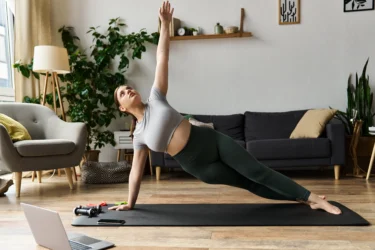
The front plank is a simple form of this exercise and may promote strengthening of the upper as well as lower body. The side plank, on the other hand, helps to strengthen the oblique abdominal muscles. This can be beneficial in reducing belly fat. However, a reverse plank is a slightly uncommon variation of this popular exercise pose. It is, as the name suggests, a reverse of the original position and helps to strengthen your hip muscles (glutes) and hamstrings (back thigh muscle), back & shoulder/
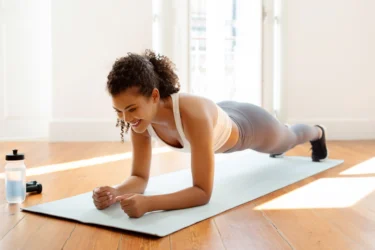
The 2-minute plank test involves holding the traditional plank position for a full two minutes. While this may appear manageable for those who exercise regularly, it can be quite demanding for beginners. This variation serves as an effective way to assess core muscle endurance and overall stability.
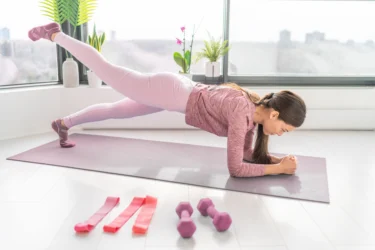
These variations are considered more advanced forms of the plank, as they place greater demand on the core muscles, helping to further enhance strength and stability. To perform them, begin in the standard plank position and lift either one arm or one leg, alternating between sides to increase intensity. For added challenge and variety, these movements can also be combined with side planks to engage a broader range of muscle groups.

This is one of the most challenging and effective plank variations, often recommended for individuals with an established fitness routine. However, with consistent and careful practice, it can also be performed at home. To do this exercise, begin in a side plank position and draw the upper leg towards the body in a movement similar to a crunch. This variation engages the core abdominal muscles while also helping to strengthen the muscles around the hip joints.
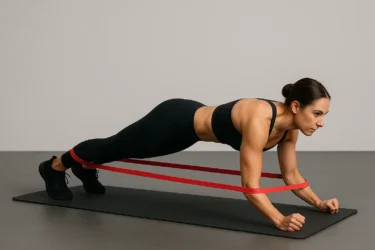
This variation can also be performed using resistance bands and is considered an advanced form of the plank exercise. It is suitable for individuals who have built confidence with the basic variations. To practise this, position yourself in the standard plank and secure a resistance band around your wrists and ankles. While holding the posture, gently push outwards against the resistance. This added tension increases the challenge, helping to further engage and strengthen the muscles and supporting joints.
The plank exercise is primarily aimed at developing stamina, muscular endurance, and core strength. It targets key muscle groups, including the erector spinae (ES), external oblique (EO), and rectus abdominis (RA), all of which play a vital role in maintaining posture and supporting spinal alignment.
Dr. Rajeev Singh, BAMS
Level: Beginner
Type: Forearm Plank (Low Plank)
The Forearm Plank, also known as the Low Plank, is a fundamental core-strengthening exercise that focuses on building endurance, stability, and muscle control. It involves maintaining a straight, aligned position while resting the body’s weight on the forearms and toes.
NOTE: Beginners may start with shorter durations and build up gradually. Proper form is essential to prevent strain, especially on the lower back.
Do not do planks in the following cases:
NOTE: If you experience any of the discomforts or pains mentioned above, it is advisable to consult a medical professional for further guidance before continuing with this exercise.
Ultimately, take time to enjoy the entire process. With consistent effort and patience, you will gradually become stronger and more resilient. As your endurance improves, continue to challenge yourself by adding a few extra seconds to your plank hold — and take pride in your progress.
The plank exercise can contribute to overall calorie expenditure when practised regularly and as part of a balanced fitness routine. For best results, it should be complemented by a healthy and nutritious diet. Incorporating foods such as fresh fruits, whole grains, yoghurt, bananas, avocados, green tea, and lean proteins like fish may support overall well-being and energy levels.
When performing the plank, it is important to maintain proper form. Try to hold the position for 10 seconds at a time between movements, gradually building up to a total of 60 seconds per session, based on your comfort and ability. Consistency and correct technique are key to making steady progress.
Plank exercises involve multiple muscle groups across the body, particularly the core, arms, and shoulders. As a full-body movement, planks may also support improved posture and help reduce strain on the lower back when performed correctly. For this reason, it is essential to maintain proper form during the exercise. Poor technique can lead to unnecessary stress on joints and muscles, potentially resulting in discomfort or injury to areas such as the wrists, shoulders, neck, or lower back.
In both high planks (full arm extended) and low plank (only forearms) exercises, a common mistake is allowing the hips to drop below the natural alignment of the body. This misalignment reduces engagement of the core muscles—one of the primary targets of the exercise—and can place undue strain on the lower back and shoulders. To correct this, ensure your hips remain level and in line with your shoulders throughout the duration of the plank. Maintaining a straight, stable posture is key to performing the exercise safely and effectively.
When performing side planks, placing your supporting arm too far from your body can lead to unnecessary strain on the shoulder, wrist, and neck. To avoid this, your shoulder should be positioned directly above the supporting wrist or elbow, depending on the variation. For correct alignment, ensure your support hand (or forearm) is directly beneath the shoulder, your upper arm is extended vertically above you, and your legs are stretched out in a straight line. This forms a ‘T’ shape with your body and helps maintain balance, stability, and proper muscle engagement.
A common mistake during plank exercises is angling the palms inward towards the centre of the body. This positioning can make it more difficult to stabilise the shoulders and may lead to the chest collapsing towards the floor, increasing the risk of strain. To maintain proper form and reduce the likelihood of injury, ensure your hands are placed parallel to each other, with fingers slightly turned outwards. Keep the elbows straight but not locked, allowing the shoulders to remain engaged and the chest lifted in a stable position.
Also Read: 7 Best Exercises to Lose Weight at Home
Given the numerous benefits associated with this seemingly simple exercise, it is no surprise that the plank posture has gained popularity among fitness enthusiasts. Many fitness professionals have introduced their own innovative variations, offering unique ways to challenge and engage the body. Even if these advanced forms are not accessible at first, the variations and tips outlined here provide effective alternatives that can yield comparable results. As a full-body exercise that complements a wide range of workout routines, the plank is a valuable addition to any fitness programme and well worth incorporating into your regular practice.
Also Read: Benefits of Sarvangasana (Shoulder Stand) and How to Do It By Dr. Himani Bisht
Yes, a 3-minute plank workout is achievable, particularly for those following an advanced fitness routine. For beginners, holding a plank for one minute is generally sufficient and effective. Reaching the three-minute mark typically indicates a higher level of core strength and endurance. However, if you are unable to maintain proper form for up to 120 seconds during an advanced routine, it may suggest the need to further develop your strength or reassess your technique. Ensuring correct posture is essential for both safety and effectiveness.
Incorporating planks into your daily routine can offer several potential benefits, particularly when performed with proper form and as part of a balanced fitness programme. Some of the key advantages may include:
– Improves body flexibility
– Strengthens the arms, legs, and spinal muscles.
– Improves running speed and efficiency
The recommended duration for planking varies depending on individual fitness levels and any underlying medical conditions. For most people, holding a plank for up to two minutes is sufficient to build core strength and endurance. Beginners may start with a 30-second hold and gradually increase the duration as their strength improves. It is always advisable to listen to your body and consult a healthcare or fitness professional if you have any concerns or pre-existing health conditions.
It is common to experience trembling or shaking while holding a plank, particularly when you are new to the exercise. This occurs because the movement requires your muscles to support your entire body weight, placing significant demand on the core, shoulders, arms, and legs. The shaking is a sign that your muscles are being challenged and are working to stabilise your body. As your strength and endurance improve over time, this response typically becomes less pronounced.
No, while plank exercises are highly effective for strengthening the core, spine, and shoulders, as well as supporting posture and flexibility, they alone are not sufficient for overall physical conditioning. Planks can contribute to maintaining fitness and may assist in reducing body fat as part of a broader routine. However, for comprehensive health and visible physical transformation, it is recommended to combine planks with cardiovascular activities such as jogging, cycling, swimming, or walking, along with strength training and a balanced, nutritious diet.
Disclaimer: The information provided here is for educational/awareness purposes only and is not intended to be a substitute for medical treatment by a healthcare professional and should not be relied upon to diagnose or treat any medical condition. The reader should consult a registered medical practitioner to determine the appropriateness of the information and before consuming any medication. PharmEasy does not provide any guarantee or warranty (express or implied) regarding the accuracy, adequacy, completeness, legality, reliability or usefulness of the information; and disclaims any liability arising thereof.
Regular physical activity is a vital component of maintaining overall health. Exercise contributes not only to weight management but also supports cardiovascular health, bone strength, mood regulation, and general wellbeing.
It is important to understand that both exercise and diet work together to support sustainable weight management. If one is prioritised while the other is neglected for example, exercising regularly without dietary changes, or following a diet without physical activity the body’s response may vary. This could lead to slower progress, fatigue, or changes in metabolism1.
Additionally, other factors such as sleep quality, stress levels, certain medical conditions (e.g., hypothyroidism, polycystic ovary syndrome), and medications can influence how the body responds to efforts aimed at weight loss.
For individuals diagnosed with conditions such as diabetes, incorporating exercises for diabetes which are appropriate to their health status can be beneficial. However, any exercise regimen should be discussed with a healthcare provider to ensure safety and effectiveness.
Here, we outline seven effective and popular exercise programmes that can be practised at home, helping you improve strength, fitness, and overall wellbeing, without the need for gym access or specialised equipment.
For those aiming to manage their weight, a combination of cardiovascular activity and resistance training, performed consistently, may offer benefits when paired with a balanced, calorie-conscious diet. Incorporating resistance training at least twice a week may help maintain muscle mass during weight loss.
Some research has explored whether the timing of exercise, such as working out in the morning affects weight loss or muscle development2. Cortisol, a hormone that follows a natural daily rhythm, typically peaks in the early morning. However, its effects are complex. Elevated cortisol levels under stress can sometimes contribute to muscle breakdown and fat retention. Current evidence does not conclusively support a “best” time of day for exercise that applies to everyone.

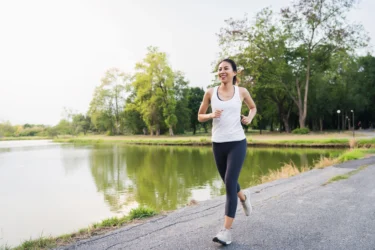
Walking is widely regarded as an accessible and low-impact form of cardiovascular exercise. When performed at a brisk pace, it can support calorie expenditure and be easily integrated into daily routines. It is also gentle on the joints, making it suitable for individuals across a wide range of fitness levels.
Some observational studies have noted that individuals who walk for 50–70 minutes, three times per week, may experience modest reductions in body fat and waist circumference over time. However, results can vary depending on individual factors such as diet, metabolism, and overall activity levels.
Jogging and running are more vigorous forms of aerobic exercise and involve higher levels of intensity. These activities primarily engage the lower body and cardiovascular system, and they may contribute to improved endurance, heart health, and calorie expenditure. The key distinction between jogging and running lies in the pace, jogging typically ranges from 6–9 km/h, while running generally starts from around 10 km/h.
On average, a person may burn approximately 298 calories in 30 minutes of jogging and 372 calories in 30 minutes of running, though actual figures depend on body weight, intensity, and terrain. While these exercises can assist in reducing overall body fat, it is important to note that fat loss from specific areas, such as the abdomen cannot be targeted directly and depends on total fat reduction and individual physiology3.
Although jogging and running can help maintain muscle tone, especially in the lower body, significant gains in muscular strength typically require resistance training or structured strength-based workouts.
Exercise Pattern
Set aside 1 hour of your time and include these exercises in your routine.
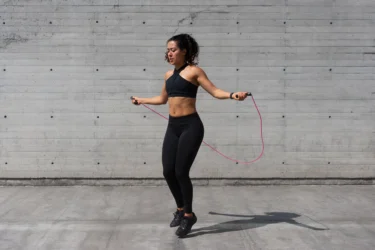
While skipping can assist with muscle toning and calorie expenditure, significant muscle strength gains require dedicated resistance training. It may also support mood and stress management, but it is not a substitute for professional mental health care4.
As with any exercise, individual results may vary depending on fitness level, diet, and consistency.
Exercise Pattern
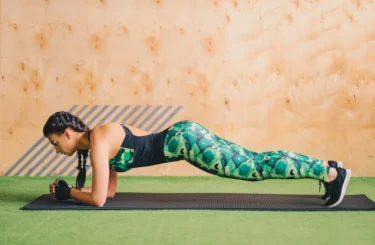
The plank is a core stabilisation exercise that targets multiple muscle groups including the abdominals, shoulders, back, chest, and hips. Though it appears simple, it requires muscular endurance and can be physically demanding when performed correctly.
Planks help improve core strength, posture, and body balance, and come in various forms to target different muscle areas. While not designed for high calorie burn or direct fat loss, planks are valuable for enhancing overall stability and muscular endurance5.
Increasing the duration and consistency of plank practice may lead to better functional strength and support in other forms of exercise.
Plank Exercise Variations
Exercise Pattern
The Reverse Plank: This exercise is a variation of the standard plank, performed in a reversed position. It is an excellent way to stretch the body while also helping to reduce excess fat and calories. Additionally, this workout strengthens the core, shoulders, back, chest, and gluteal muscles.
Exercise Pattern
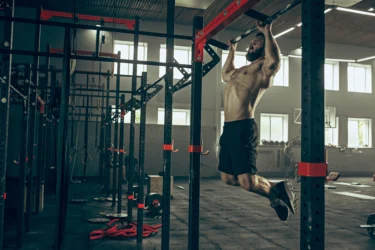
Push-ups are a widely practised bodyweight strength exercise that require no equipment and can be performed virtually anywhere. They primarily target the chest, triceps, shoulders, and core, helping to build upper body strength and muscular endurance.
While push-ups do not burn as many calories as aerobic exercises, they contribute to muscle development, which may support long-term weight management by modestly increasing resting metabolic rate6.
Regular push-up training can improve overall physical stability and strength, particularly when combined with other forms of exercise such as cardio or resistance training.
Exercise Pattern
Push-ups are a widely practised bodyweight strength exercise that require no equipment and can be performed anywhere. They primarily target the chest, triceps, shoulders, and core, contributing to the development of upper body strength and enhancing muscular endurance.
While push-ups do not burn as many calories as aerobic exercises, they contribute to muscle development, which may support long-term weight management by modestly increasing resting metabolic rate.
Regular push-up training can improve overall physical stability and strength, particularly when combined with other forms of exercise such as cardio or resistance training.
Exercise Pattern
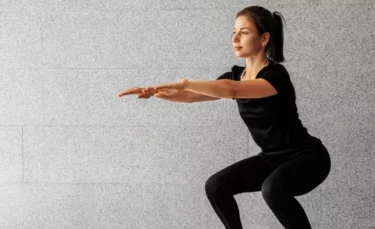
Squats are a lower-body strength exercise that primarily target the thighs, hips, and glutes. They help improve mobility, balance, and muscular endurance, making them a fundamental part of many fitness routines.
While squats may contribute to calorie expenditure and muscle toning, their main benefit lies in strengthening the lower body. Beginners are often advised to start with 3 sets of 12–15 repetitions, focusing on proper form to avoid injury and maximise effectiveness7.
Exercise Pattern:
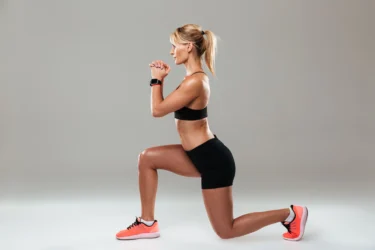
Lunges are a lower-body strength training exercise that primarily target the quadriceps, glutes, hamstrings, and engage the core for stability. They are effective for building lean muscle, improving balance, coordination, and lower body endurance.
While lunges can be part of a fat-loss programme when included in a high-intensity routine, their primary role is in toning and strengthening. Using added weights can further enhance their effectiveness, especially for athletic training and improved overall fitness8.
Exercise Pattern
Along with exercises that need to be done at your place for weight loss. There are other factors and methods that can be helpful for weight management.
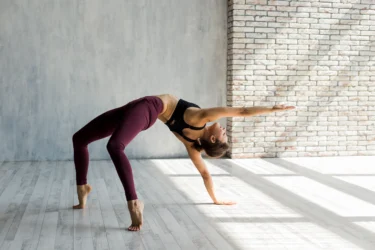
Yoga is an ancient practice that integrates physical postures, controlled breathing, mindfulness, and relaxation. When combined with healthy eating and regular activity, yoga may support weight management, improve mental wellbeing, and enhance body awareness9.
While not primarily focused on calorie burning, yoga promotes stress reduction, which can positively influence lifestyle habits. Some forms of yoga may also support flexibility, balance, and metabolic health such as yoga for diabetes, making it a valuable addition to a holistic wellness routine.
Along with supporting weight management, yoga offers a range of additional benefits, including:
Specific yoga poses play a supportive role in weight management by enhancing muscle tone, balance, and concentration. Regular practice helps the body adapt to these movements, allowing you to gradually improve strength, flexibility, and mind-body awareness, all of which contribute to overall well-being and fitness.
Some of the yoga poses that should be practiced for weight loss are:
Below is a general guide to the approximate number of calories burned during various exercises, based on moderate intensity. Actual values can vary depending on factors such as body weight, age, fitness level, workout intensity, and duration:
While many prefer to exercise in the morning, especially on an empty stomach, believing it may support fat metabolism, the most important factor is consistency. Morning workouts can help align your circadian rhythm, supporting better sleep and routine adherence over time.
Some studies suggest evening workouts may improve performance due to increased body temperature and oxygen efficiency. However, research remains inconclusive. Ultimately, the best time to exercise is the time that suits your schedule and lifestyle, allowing you to remain active regularly and sustainably.
Also Read: 8 Effective Exercises That Help with Weight Loss!
Follow these tips to make sure your weight loss programme at home is done properly:
Also Read: Benefits of Doing the Plank Exercise Every Day
No, weight loss is a combination of regular workouts and a proper diet. It is important to ensure to follow both to achieve the desired results.
No, sweating is your body’s natural way of regulating temperature. As your internal temperature rises, your body releases sweat, which cools the skin through evaporation. It is a sign of thermoregulation, not necessarily an indicator of calorie burn or workout intensity.
To improve fitness and maintain good health, it is advisable to exercise at least 2–3 times per week consistently, rather than sporadically. Regular workouts yield better long-term results.
A general way to estimate daily calorie intake for weight maintenance is to multiply your ideal body weight (in pounds) by 14. For example, if your ideal weight is 135 pounds, you may need around 1,890 calories per day (135 × 14).
Some initial weight loss in a week is possible through regular exercise, mindful eating, and increased activity. However, early changes are often due to water loss, not fat. For safe and lasting results, aim for 0.5 to 1 kg per week through a balanced diet, moderate calorie deficit, and consistent physical activity.
Weight loss occurs when you burn more calories than you consume. While reducing calorie intake can lead to a calorie deficit, completely avoiding food is not a healthy approach. The body may slow its metabolism and trigger energy conservation, making weight loss harder over time. It’s essential to eat balanced, nutritious meals to support both health and sustainable weight loss.
Any foods with high carbohydrates and fats should be avoided if you want to lose weight. These include french fries, potato chips, white bread, pastries, cookies and sugary drinks.
Disclaimer: The information provided here is for educational/awareness purposes only and is not intended to be a substitute for medical treatment by a healthcare professional and should not be relied upon to diagnose or treat any medical condition. The reader should consult a registered medical practitioner to determine the appropriateness of the information and before consuming any medication. PharmEasy does not provide any guarantee or warranty (express or implied) regarding the accuracy, adequacy, completeness, legality, reliability or usefulness of the information; and disclaims any liability arising thereof.
« Previous Page